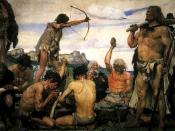In our modern world, it seems that everything, from business to transportation is progressing at an ever accelerating pace compared to how it was 100 or even 50 years ago. For instance, in the 18th century, General George Washington was able to successfully lead his army to victory in the American Revolution after quitting the military for 15 years. In today's fast paced world, such a feat would be impossible to accomplish. Imagine a soldier who fought in the Persian Gulf War leaving the military, then rejoining and fighting in the Iraqi war! An explanation for this acceleration lies in the study of anthropology. Anthropologists divide the history of humanity into several ages, such as the Stone Age, Bronze Age, Iron Age, etc., with each age being shorter than its predecessors. Several major roadblocks in the transition of caveman to human explain why the Stone Age lasted for two million years.
One of the most prominent differences between a human and an ape is the size of their brains. The brain of a modern human is 3 times the size of what it was 2 million years ago due to a human's long generation rate of about 13 years. As a result, it wasn't until 12,000 years ago that man learned how to make a fire, and it wasn't until 2,000 years later that man began to change his hunter-gatherer lifestyle.
In addition, during the Stone Age, several ice ages occurred. Man had to adapt to changing climates and conditions. Furthermore, man was constantly on the move, chasing herds of mastodons and other sources of food. As a result, humans kept their hunter-gatherer lifestyle until after the last glacier retreated, paving the way to the Agricultural Revolution, which marked the end of the Stone Age.
Isolation was...


